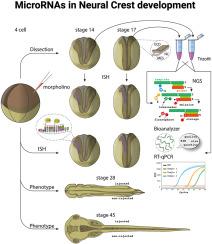MicroRNA miR-196a controls neural crest patterning by repressing immature neural ectoderm programs in Xenopus embryos
IF 2.1
3区 生物学
Q2 DEVELOPMENTAL BIOLOGY
引用次数: 0
Abstract
Neural crest (NC) cells form a multipotent stem cell population specified during neurulation, which undergo an epithelial-to-mesenchymal transition (EMT) and migrate extensively in the developing embryo, to generate numerous tissues and cell types including the craniofacial skeleton, the peripheral nervous system and pigment cells. The genetic and molecular details of NC specification are governed by a complex, yet still partially understood gene regulatory network (NC-GRN). In particular, the precise function of microRNAs (miRNA) in this network remains poorly characterized. MiRNAs are short non-coding 20–22 nucleotides long RNAs, which control gene expression through post-transcriptional repression. Since miRNA-196a is expressed in the developing neural and NC cells of Xenopus laevis embryos, we here investigated miR-196a function in the NC-GRN, by knocking-down its expression using antisense morpholinos. Depletion of miR-196a revealed major NC and craniofacial phenotypes. These defects were preceded by the perturbed expression of key neural, neural border and NC markers such as sox2/3, zic1/3, pax3, sox10 and snail2. Using RNA sequencing of individual neural border and NC explants, we have identified a signature of genes up- and down-regulated by miR-196a and validate these with rescue experiments using a miRNA mimic. Our study identifies miR-196a as a key actor of early patterning in the dorsal ectoderm, balancing the extent of immature neural plate progenitors with NC and placode specification, while also promoting neuron differentiation within the neural plate.

MicroRNA miR-196a通过抑制爪蟾胚胎中未成熟的神经外胚层程序来控制神经嵴模式
神经嵴(NC)细胞在神经发育过程中形成多能干细胞群,经历上皮细胞到间充质细胞的转化(EMT),并在发育中的胚胎中广泛迁移,产生多种组织和细胞类型,包括颅面骨骼、周围神经系统和色素细胞。NC规范的遗传和分子细节是由一个复杂的,但仍部分了解的基因调控网络(NC- grn)控制的。特别是,microrna (miRNA)在该网络中的精确功能仍然缺乏表征。mirna是一种短的非编码rna,长度为20-22个核苷酸,通过转录后抑制来控制基因表达。由于miRNA-196a在非洲爪蟾胚胎发育中的神经细胞和NC细胞中表达,我们在这里研究了miR-196a在NC- grn中的功能,通过使用反义morpholinos敲低其表达。miR-196a的缺失揭示了主要的NC和颅面表型。在这些缺陷发生之前,主要的神经、神经边界和NC标记如sox2/3、zic1/3、pax3、sox10和snail2的表达受到干扰。利用单个神经边界和NC外植体的RNA测序,我们已经确定了miR-196a上调和下调的基因特征,并使用miRNA模拟物进行了救援实验验证。我们的研究发现miR-196a是背外胚层早期模式的关键参与者,平衡未成熟神经板祖细胞与NC和位点规范的程度,同时也促进神经板内的神经元分化。
本文章由计算机程序翻译,如有差异,请以英文原文为准。
求助全文
约1分钟内获得全文
求助全文
来源期刊

Developmental biology
生物-发育生物学
CiteScore
5.30
自引率
3.70%
发文量
182
审稿时长
1.5 months
期刊介绍:
Developmental Biology (DB) publishes original research on mechanisms of development, differentiation, and growth in animals and plants at the molecular, cellular, genetic and evolutionary levels. Areas of particular emphasis include transcriptional control mechanisms, embryonic patterning, cell-cell interactions, growth factors and signal transduction, and regulatory hierarchies in developing plants and animals.
 求助内容:
求助内容: 应助结果提醒方式:
应助结果提醒方式:


